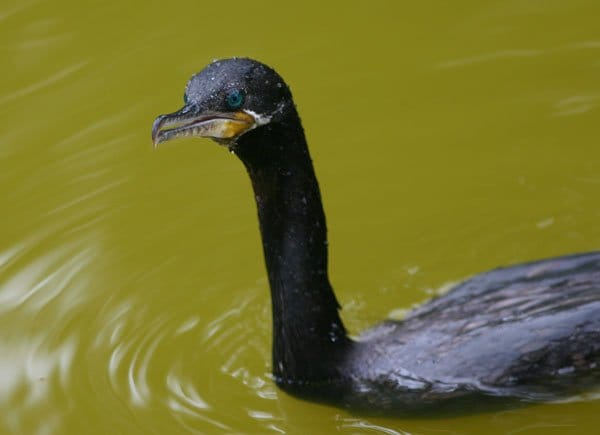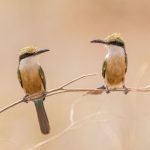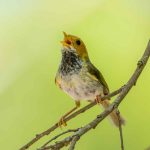What is a Cormorant or a Darter?
Pity the poor cormorant. There’s scarcely a bird in the world as unfairly maligned, deemed the world over as a bad seed due to its ungainly proportions and reportedly insatiable appetite for bait fish. But this awkward family is of an ancient lineage, one of the oldest of all the birds and with similar ancestors reaching all the way back to the dinosaurs. The form is a classic one – long-billed, web-footed, and waterborne – and shared in some sense with the order of birds the cormorants, and their sister taxa the darters, lie within, the newly resurrected Suliformes. That group consists of the two families treated here, along with the boobies, frigatebirds, and tropicbirds, all highly aerial marine species. The comparatively aquatic and frequently freshwater cormorants and darters are outliers, both in habitat preferences and panache, but we’re all about the underdogs here. Let’s take the two families together, and then separately.

Reed Cormorant, Kenya, by David Ringer
Both cormorant and darters are superb swimmers, specializing in pursuing fish underwater before returning to the surface where they sit, characteristically quite low in the water, and swallow them head-first. Both families use their feet for propulsion, and as such those appendages are uniquely webbed across all four toes, effectively broadening the surface area they use to propel themselves. It’s a trait they share with the other Sulids, as well as the pelicans.
 Flightless Cormorant, Galapagos, by Scott Winton
Flightless Cormorant, Galapagos, by Scott Winton
Cormorants and darters are long-bodied and that, paired with feet at the far end of their bodies, makes them awkward when out of the water. Though powerful flyers, they’re rather ungainly when taking off from the surface, but it’s on land that we see that most famous of cormorant behaviors. Sitting atop a cliff face or piece of flotsam following a fishing outing, they’ll spread their wings wide to dry. It’s suggested that this is because they lack the oils found in other birds to waterproof their feathers, but that’s not true. Waterproofing is an innate characteristic of feathers due to their physical structure. No extra oil is required. But both cormorants and, in particular, darters are unique in having feathers that are less naturally water-resistant than other birds, an adaptation that enables them to forage underwater more easily. However, this necessitates regular time out of the water to dry sodden feathers and regulate body temperature; the time spent in that classic crucificial position.

Anhinga, Brunswick Co, NC, by Nate Swick
Cormorants and Shags (Phalacrocoracidae)
Taxonomically, a cormorant and a shag is a distinction without a difference. The family Phalacrocoracidae consists of 40-odd species with a worldwide distribution and, despite the common name, all of them currently reside in the genus Phalacrocorax according to most taxonomic resources. That universal cormorant latin epithet roughly translates to “bald raven”, a reference not to the lack of feathers on what is generally a crested head, but to the large white cheek patch on the face of the prototypical cormorant. The one known in North America as Great Cormorant, but in Europe as the definitive article. This unoriginal concept of naming every big black bird some sort of raven – itself the original big, black bird – informed the common name too, as “Cormorant” is a contraction of the latin corvus marinus, or “sea raven”.

Great Cormorants, Spain, by James Meehan
Shags on the other hand, while being hilarious to our non-birding anglophile friends, don’t appear to be taxonomically distinct, and the term is generally used to describe only the smaller, stubbier-billed, cormorants. Shags do, however, typically have a jaunty tuft of feathers on the head, or at least the original shag, Eurasian Shag, does, which differentiates it from the plainer original cormorant.
Phalacrocorids range in size from the aforementioned Great Cormorant to the dainty Pygmy Cormorant of southern Europe. While most cormorants are humbly attired in nappy black, several species, particularly in the southern hemisphere, are real stunners with varying shades of white and steely gray and colorful feet and faces. Chile and Argentina seem to harbor the classiest looking corms, and the Imperial Shag and Red-legged Cormorant are as beautiful as anything you’re going to find in the tropics.

Pygmy Cormorant, Italy, by Robin Knapp
Here in North America, the Double-crested Cormorant reigns supreme, arguably one of the most common species on the continent, so much so that several states and municipalities have decided that the birds need to be periodically culled to protect fish stocks. Though there is no good evidence that cormorants have a negative impact on gamefish, it is sadly not a species that sees many rally to its defense. Maybe it’s the dour look. Throughout Central and South America, one can usually find the Neotropic Cormorant, formerly called Olivaceaous due to its iridescent greenish sheen.

Neotropic Cormorant, Bahamas, by Mike Bergin
In North America, it’s on the Pacific coast where cormorant diversity reaches its peak. There, blue-faced Brandt’s Cormorants and dainty Pelagic Cormorants share space on rocky shorelines, the preferred habitat of most of the family’s members from California to South Africa, where Bank Cormorants and Crowned Cormorants fill nearly identical niches.

Crowned Cormorant, South Africa, by Adam Riley
Anhinga and Darters (Anhingidae)
The long-tailed, slim-necked darters are among the most specialized of an order full of specialization. While cormorants have hooked bills for snatching fish out of the water, darters are true anglers. They use their spear-like beaks to impale their prey, requiring them to perform an elaborate, learned, maneuver to toss the fish from beak to throat. The four species are often referred to collectively as “Snakebirds” for their penchant for swimming submerged but for their slender neck and head above the water’s surface looking for all the world like a tropical serpent.

Anhinga, Florida, by Nate Swick
The name Anhinga, from which the genus and family is derived, comes to us from the indigenous Amazonian Tupi people, who called them ajínja, which literally translates to ”little head”. The Tupi apparently had a real problem with their disproportionate dimensions because they considered the homely Anhinga, the New World version of the global family, to be an evil spirit and called it “devil bird”. An unfortunate characterization, but not completely undeserved as the birds look no small bit malevolent as they swim with body completely submerged save for that long neck, tiny head, and dagger bill.
For the bird’s sake, though, it’s a good thing we know better
–=====–
Double Crested Cormorant – Phalacrocorax auritus
- Blast from the Past, Liza Lee Miller
- How do Cormorants take off from the water? – Search and Serendipity, David Ringer
- Can we please have a scientific cormorant policy in Minnesota? – Greg Laden’s Blog, Greg Laden
- Photo Study: Double-crested Cormorants – The Nemesis Bird, Alex Lamoreaux
- The soaring DC Cormorant Identification Issue – Huron River Birding, Laurent Fournier
- A Cormorant taking off from the water…doing the Cormorant Hop! – Red and the Peanut, Kelly Riccetti
- Double-crested Cormorant – My Bird of the Day, Peter Thoem

Double-crested Cormorants, Florida, by Charleen Turner
Bank Cormorant, Phalacrocorax neglectus
- Birding with Great White Sharks – The Nemesis Bird, Alex Lamoreaux
Crowned Cormorant, Phalacrocorax coronatus
- Rooiels – Funny Name, Serious Birding – 10,000 Birds, James Curie
Neotropic Cormorant, Phalacrocorax brasilianus
- Color me Olivaceous – 10,000 Birds, Mike Bergin
- The “Paticuervo” – Jan Axel’s Blog, Jan Axel Cubilla Rodríguez

Indian Cormorant, Thailand, by Dale Forbes
Indian Cormorant, Phalacrocorax fuscicollis
- Laem Pak Bia Birding, Thailand -10,000 Birds, Dales Forbes
Brandt’s Cormorant, Phalacrocorax penicillatus
- Days of Guano – 10,000 Birds, Duncan Wright

Brandt’s Cormorants, California, by Duncan Wright
Great Cormorant, Phalacrocorax carbo
- Spanish Bird of the Week #7, Great Cormorant – Birding Bros Blog, James Meehan
- Fri-D – Cormorants – The Freiday Bird Blog, Don Freiday
Common Shag, Phalacrocorax aristotelis
- Steady Season for Shags – Farne Islands Blog
Imperial Shag, Phalacrocorax atriceps
- Take a dive with an Imperial Cormorant – The Perch, Justine Hausheer
Anhinga, Anhinga anhinga
- An Anhinga sitting on a nest… – Red and the Peanut, Kelly Riccetti
- Snakebird – The Drinking Bird, Nate Swick

Australasian Darter, Australia, by Duncan Fraser
Australasian Darter, Anhinga novaehollandiae
- Breeding Bonanza – Ben Cruachan Blog, Duncan Fraser
Oriental Darter, Anhinga melanogaster
- Darter or Snakebird Sunning – Bird Ecology Study Group, Y C Wee
General Cormorants and Darters
- Meet Suliformes, one of the newest orders of birds – 10,000 Birds, David Ringer
- Cormorants of South Africa – The Nemesis Bird, Alex Lamoreaux
- Seabirding off Cape Point – 10,000 Birds, Patrick Cardwell














A beautiful edition, Mr. Swick.
Great Edition! I finally found my post to add…late ha.. Here it is. http://dawnandjeffsblog.blogspot.com/2011/02/wings-on-wednesday.html
Great edition, Nate! So happy about the return of “I and the Bird!” Learned a lot and only snickered a little bit about “Shags.” So immature of me but there you go!
These birds simply amaze me. I love photographing them. Living in Florida, I get to see the Snakebirds almost daily. Thanks so much for the education. Great information!